The Grey Persian cat captures hearts with His luxurious coat, enchanting eyes, and calm personality. These long-haired beauties have been adored for centuries, earning a reputation as one of the most elegant and affectionate cat breeds. Whether lounging like royalty or following their favorite human around the house, Grey Persian cats bring warmth and charm to any home.
If you love fluffy cats with sweet, loving temperaments, a Grey Persian cat might be the perfect companion for you. In this article, you’ll discover ten fascinating facts about these majestic felines. From their unique history to essential care tips, each fact will deepen your appreciation for this stunning breed.
The Elegant History of Grey Persian Cats
Origins of the Persian Cat Breed
Persian cats have a long and interesting history that goes back many years. Their journey began in ancient Persia (modern-day Iran), where traders and explorers admired their luxurious coats and regal appearance. Early records suggest that Persian cats first arrived in Europe in the 1600s when Italian and French travelers introduced them to aristocrats and royal families. Their striking looks and gentle personalities made them highly sought after, and European breeders worked to refine their features, resulting in the Persian cats we recognize today.
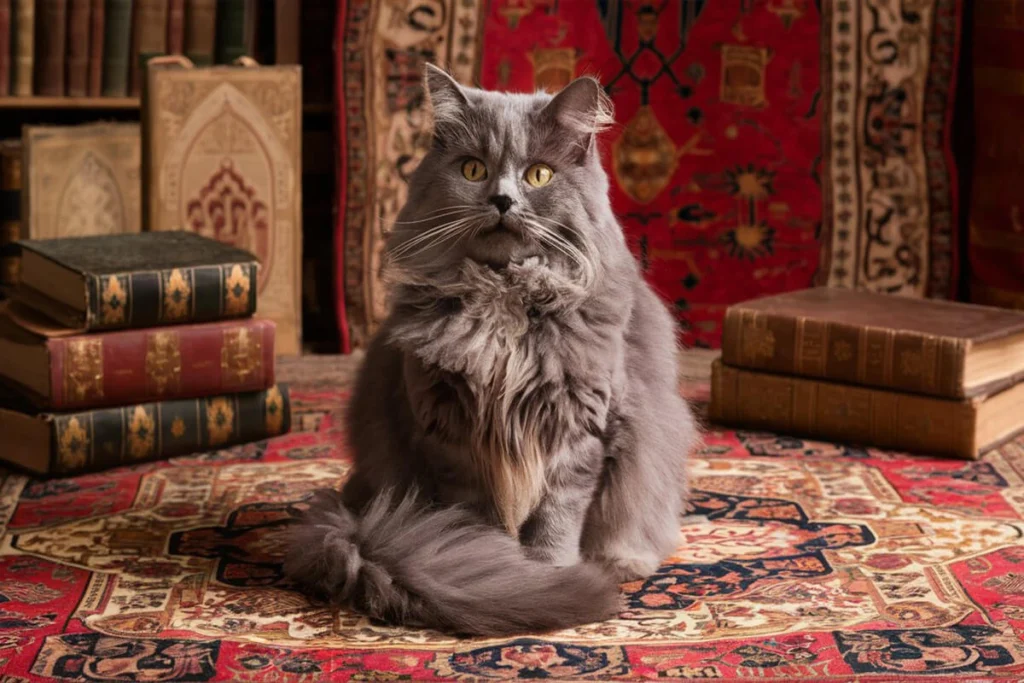
How Grey Persian Cats Became Popular
While Persian cats have always been adored, the grey variation, often called “blue Persians,” gained popularity due to their unique and elegant appearance. Early cat enthusiasts admired their silver-blue coats, which gave them a mystical and aristocratic aura. As Persian cats became a favorite in cat shows and high society, the grey variety stood out for its striking beauty. Celebrities, artists, and even royalty helped boost their appeal by keeping them as cherished pets. Over time, Grey Persian cats became one of the most beloved colors in the breed, thanks to their luxurious fur and calm, affectionate nature.
Their Role in Cat Shows and Breeding
Cat shows have played a significant role in shaping the Persian cat breed, including the grey variety. Breeders worked tirelessly to enhance their signature long coats, round faces, and sweet expressions. Organizations like The International Cat Association (TICA) and the Cat Fanciers’ Association (CFA) set strict breed standards, which helped maintain the Persian cat’s distinct look and temperament. Grey Persian cats continue to shine in cat shows worldwide, impressing judges and cat lovers with their grace and poise. Their popularity in breeding programs ensures that future generations can enjoy these stunning, fluffy companions.
Unique Personality Traits of Grey Persian Cats
Affectionate and Gentle Nature
Grey Persian cats have a reputation for being some of the most affectionate and gentle felines. They form deep bonds with their owners and love spending time in a peaceful, cozy environment. Unlike some high-energy breeds that constantly demand attention, Grey Persians prefer quiet companionship. They enjoy curling up beside their favorite person, purring softly while soaking in the affection. Their calm and patient nature makes them excellent pets for individuals and families who appreciate a relaxed, loving cat.
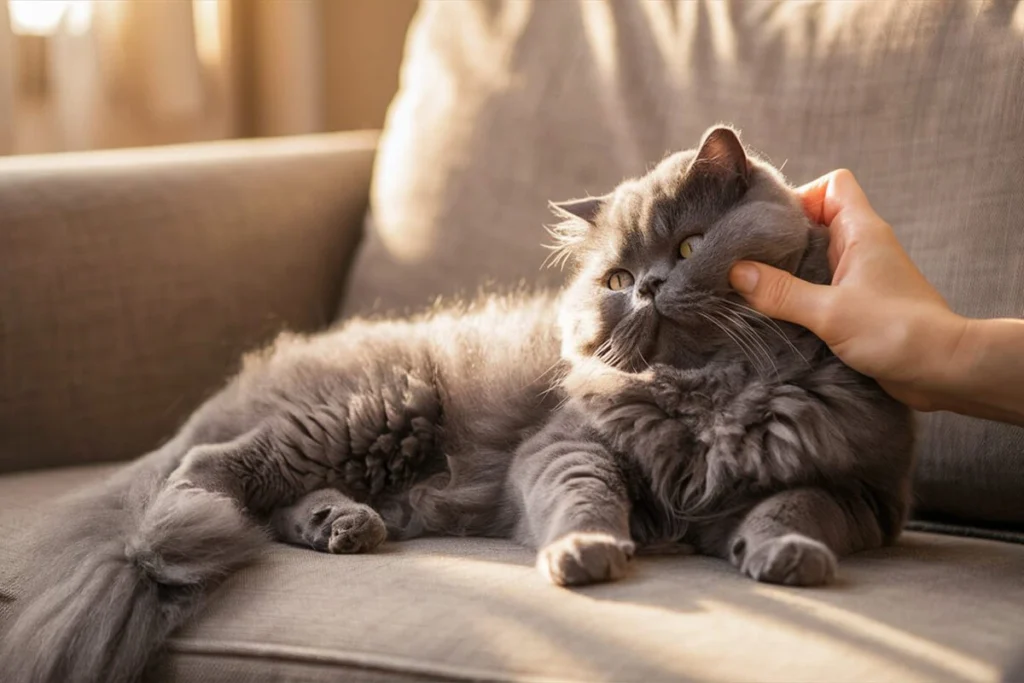
How They Interact with Humans and Other Pets
Grey Persian cats adore human companionship and often choose a favorite person in the household. They don’t demand constant attention, but they thrive on love and gentle affection. Many will follow their owners from room to room, content to sit nearby rather than engage in hyperactive play. These cats enjoy being pampered, so they respond well to gentle petting and grooming sessions.
When it comes to other pets, Grey Persians typically get along well, especially with calm and friendly animals. They may take some time to warm up to new companions, but once they feel comfortable, they coexist peacefully. They don’t enjoy rough play, so they prefer other gentle pets, such as well-mannered cats or laid-back dogs. If introduced properly, they can form strong bonds with other household animals, often choosing a cozy spot to nap together.
Common Behaviors and Quirks
Grey Persian cats have several charming quirks that make them even more lovable. They love lounging in soft, warm places, whether it’s a sunlit windowsill, a fluffy blanket, or their owner’s lap. Many develop unique ways of communicating, such as soft meows, chirps, or even expressive eye contact when they want attention.
Unlike highly energetic breeds, Grey Persians prefer a slow-paced lifestyle. They enjoy playtime, but they engage in short bursts of activity rather than non-stop running and jumping. Their favorite toys often include feather wands, plush mice, or rolling balls that they can bat around at their own pace. Some even enjoy puzzle toys that challenge their intelligence without requiring too much physical effort.
One of their most endearing traits is their love for routine. Grey Persians thrive on consistency, whether it’s mealtime, nap time, or grooming sessions. They appreciate a calm, predictable environment where they feel safe and loved. With their gentle nature and affectionate personality, Grey Persian cats bring a soothing presence to any home.
Essential Care Tips for Your Grey Persian Cat
Best Food for Persian Cats to Maintain Health
Feeding a Grey Persian cat the right diet plays a huge role in maintaining its overall health, coat quality, and energy levels. Since Persian cats have long, dense fur and a brachycephalic (flat-faced) structure, they need specially formulated food that supports their unique needs. High-quality protein sources, such as chicken, turkey, or fish, help maintain strong muscles and a healthy weight. Persian cats don’t require excessive carbohydrates, so selecting grain-free or low-carb options prevents unnecessary weight gain.
Hydration remains crucial for Persian cats since they are prone to kidney issues. Wet food provides extra moisture, helping to support kidney function and prevent dehydration. Many owners mix wet and dry food to ensure their Persian gets both texture variety and essential nutrients. When choosing dry food, look for kibble specifically designed for Persian cats. Brands create these kibbles with a unique shape to make it easier for flat-faced cats to pick up and chew.
Omega-3 and Omega-6 fatty acids also contribute to a Persian cat’s luscious coat. Ingredients like salmon oil, flaxseed, and fish meal help reduce shedding and keep fur soft and shiny. Taurine, an essential amino acid, supports heart and eye health, both of which are concerns for Persian cats. Avoiding fillers, artificial preservatives, and low-quality by-products ensures a long and healthy life for a Persian cat.
Persian cats love routine, so feeding them at the same time each day prevents digestive issues and maintains a steady metabolism. Dividing meals into two or three portions instead of leaving food out all day prevents overeating and helps with weight control. Monitoring their food intake and adjusting portions based on age, activity level, and weight ensures they stay in the best shape possible.
Proper Persian Cat Grooming Techniques
Persian cats require dedicated grooming to keep their luxurious coats free from tangles and mats. Their long, thick fur traps dirt and loose hair, so daily brushing keeps their coat smooth and reduces shedding. Using a wide-tooth comb first helps detangle knots, while a fine-tooth comb removes loose hairs and prevents matting. Brushing should start from the head and move toward the tail in gentle, slow strokes to avoid pulling their delicate skin.
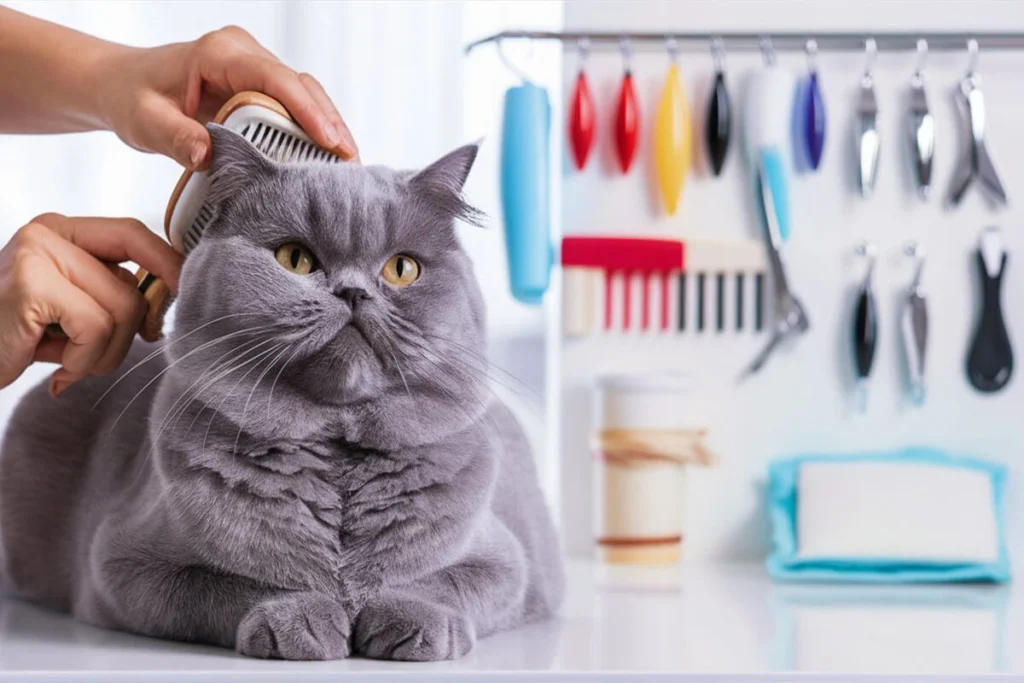
Bathing a Persian cat every three to four weeks helps remove dirt and excess oil that can accumulate in their dense fur. Using a mild, cat-safe shampoo designed for long-haired breeds ensures their coat stays soft and clean. Before bathing, brushing out any knots prevents mats from tightening when wet. After the bath, thoroughly drying the fur with a towel and a low-heat pet dryer keeps moisture from lingering, which could lead to skin issues.
Persian cats also require special attention to their eyes since their flat faces cause tear buildup. Daily eye cleaning with a soft, damp cloth or pet-safe wipes prevents tear stains and keeps their face fresh. Checking their ears for wax buildup and gently wiping them with a cat-safe ear cleaner once a week prevents infections. Keeping their nails trimmed every two to three weeks prevents overgrowth and reduces the risk of them getting caught in furniture or carpets.
Grooming a Persian cat isn’t just about keeping them looking beautiful—it strengthens the bond between the cat and its owner. When handled gently and consistently, grooming sessions become a relaxing experience that a Persian cat enjoys rather than fears. Starting a grooming routine at a young age makes them more comfortable with regular brushing, baths, and nail trims.
Essential Cat Grooming Tools Every Owner Should Have
Persian cat grooming requires specific tools to keep their thick fur in top condition. Every Persian cat owner should invest in high-quality grooming essentials to make the process easier and more effective.
- Wide-Tooth Comb and Fine-Tooth Comb – A wide-tooth comb helps detangle fur, while a fine-tooth comb removes loose hair and smooths the coat. Stainless steel combs work best since they glide through fur without causing static.
- Bristle or Pin Brush – A bristle brush distributes natural oils throughout the fur, keeping it shiny and healthy. A pin brush works well for daily maintenance and removes minor tangles before they turn into mats.
- Dematting Tool or Mat Splitter – If mats develop, a dematting tool safely removes them without pulling or hurting the cat’s skin. These tools have rounded blades designed to cut through tough tangles with minimal discomfort.
- Cat-Safe Shampoo and Conditioner – Persian cats need a gentle, moisturizing shampoo that won’t strip their fur of natural oils. A conditioner adds softness and prevents tangles, making post-bath brushing easier.
- Pet Blow Dryer or Absorbent Towels – Persian cats need thorough drying after baths to prevent damp fur from causing skin irritation. A low-heat pet dryer speeds up drying time, while microfiber towels absorb excess water quickly.
- Eye Cleaning Wipes – Since Persian cats are prone to tear staining, hypoallergenic, pet-safe eye wipes keep their faces clean. These wipes prevent bacterial buildup and reduce discoloration around the eyes.
- Nail Clippers or Grinder – Keeping a Persian cat’s nails trimmed prevents them from getting caught in fabric and scratching furniture. A nail grinder works well for smoothing edges and reducing the risk of sharp claws.
- Ear Cleaning Solution and Cotton Pads – Checking and cleaning a Persian cat’s ears prevents wax buildup and infections. A gentle ear cleaning solution paired with soft cotton pads removes debris without irritation.
Having the right grooming tools makes caring for a Persian cat easier and ensures their coat remains healthy and beautiful. Regular grooming keeps them comfortable and enhances the special bond between a Persian cat and its owner.
Health Considerations for Grey Persian Cats
Common Persian Cat Health Issues and How to Prevent Them
Persian cats are known for their beauty, but their unique physical traits also make them prone to specific health issues. Their flat faces, long coats, and genetic background contribute to several common medical conditions that owners must monitor closely.
- Brachycephalic Airway Syndrome – Persian cats have a short skull structure, which can cause breathing difficulties. They may snore, breathe noisily, or struggle in hot and humid conditions. Keeping them in a cool, well-ventilated environment prevents overheating. Avoiding intense physical activity also helps reduce breathing strain.
- Polycystic Kidney Disease (PKD) – PKD affects Persian cats at a higher rate than many other breeds. Small fluid-filled cysts develop in the kidneys, which can lead to kidney failure over time. Regular vet checkups and ultrasound screenings detect PKD early. Feeding a kidney-supportive diet with high moisture content and limiting phosphorus intake helps slow the progression of the disease.
- Hypertrophic Cardiomyopathy (HCM) – This common heart condition thickens the heart muscles, reducing their ability to pump blood efficiently. Persian cats with HCM may show signs of fatigue, difficulty breathing, or decreased activity. Scheduling annual heart screenings with a veterinarian helps detect early symptoms. Managing their weight and providing a heart-healthy diet reduces the risk of severe complications.
- Dental Disease – Due to their flat faces, Persian cats often suffer from misaligned teeth and overcrowding, making them more prone to gum infections, plaque buildup, and tooth decay. Brushing their teeth with a cat-safe toothbrush and providing dental treats or water additives helps maintain oral health. Annual dental cleanings by a veterinarian prevent serious gum disease.
- Obesity – Persian cats love lounging and relaxing, which makes them prone to weight gain. Excess weight increases their risk of diabetes, joint problems, and heart disease. Controlling portion sizes, feeding high-protein, low-carb diets, and engaging them in moderate play sessions prevent obesity-related issues.
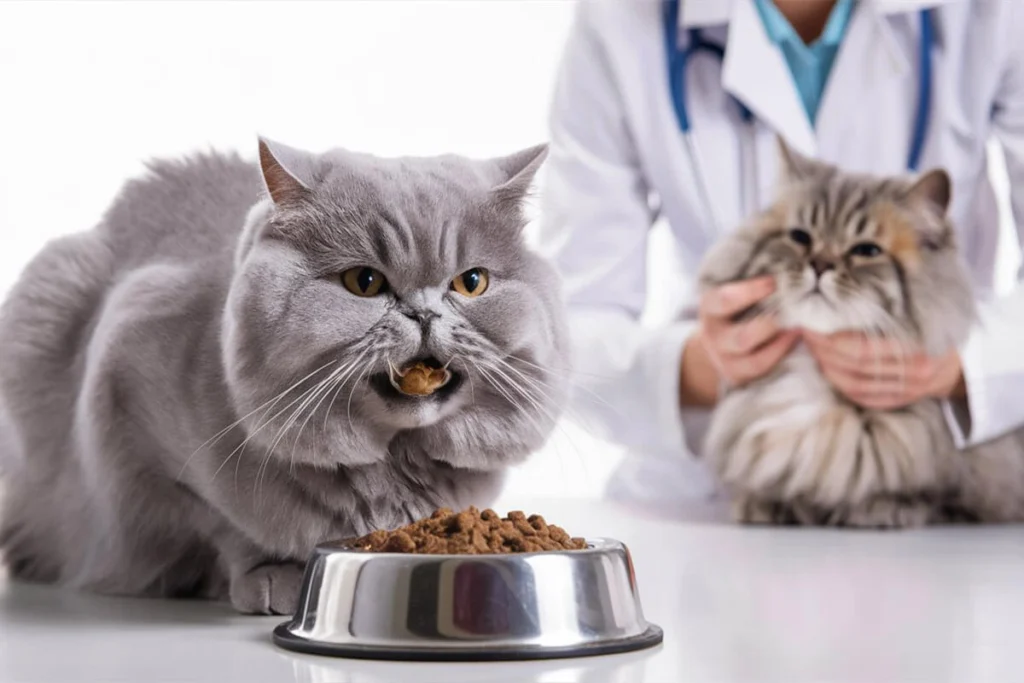
Monitoring a Persian cat’s health through regular veterinary visits, a proper diet, and daily care helps prevent serious medical conditions and ensures they live a long, happy life.
Importance of Persian Cat Eye Care
Persian cats often suffer from eye-related issues due to their flat facial structure. Their large, round eyes tend to produce excessive tears, leading to staining, irritation, and infections if not properly maintained.
- Tear Staining – Excessive tearing causes dark stains around a Persian cat’s eyes, especially in light-colored cats. The constant moisture can also lead to bacterial growth and skin irritation. Wiping their eyes daily with a soft, damp cloth or pet-safe eye wipes prevents tear staining and keeps the area clean.
- Blocked Tear Ducts – The structure of a Persian cat’s face can cause tear ducts to become blocked, leading to eye discharge and inflammation. If an owner notices persistent tearing or redness, consulting a veterinarian ensures early treatment. Warm compresses and prescribed eye drops help clear minor blockages.
- Eye Infections – Persians are prone to conjunctivitis and other bacterial infections due to their prominent eyes. Symptoms include redness, swelling, or excessive discharge. Regular eye cleaning and avoiding exposure to dust or allergens reduce the risk of infections. If an infection develops, immediate veterinary care prevents complications.
- Corneal Ulcers – Since Persian cats have large, exposed eyes, they are more likely to suffer from corneal scratches or ulcers. Even minor injuries can lead to serious infections if left untreated. Watching for signs of excessive blinking, pawing at the eye, or cloudiness ensures quick detection. A veterinarian can prescribe medicated drops to promote healing.
Maintaining proper eye hygiene keeps a Persian cat comfortable and prevents long-term health complications. Regular eye cleaning, monitoring for symptoms, and seeking veterinary care when needed ensure that their eyes remain bright and healthy.
Understanding the Persian Cat Lifespan and How to Extend It
Persian cats typically live between 12 to 16 years, but with the right care, some can reach 18 years or more. Providing a healthy lifestyle, preventive care, and a loving environment increases their chances of living a long and fulfilling life.
- Proper Nutrition – Feeding a Persian cat high-quality food with plenty of protein, healthy fats, and essential nutrients supports longevity. Wet food helps with hydration, while supplements like Omega-3 fatty acids promote heart and joint health.
- Regular Grooming and Hygiene – Keeping their coat, eyes, ears, and teeth clean prevents infections and reduces the risk of developing serious health issues. Brushing their fur daily, wiping their eyes, and maintaining oral hygiene all contribute to their overall well-being.
- Routine Veterinary Care – Annual checkups help detect health problems early. Bloodwork, heart screenings, and kidney function tests provide valuable insights into a Persian cat’s internal health. Vaccinations and parasite prevention also keep them safe from diseases.
- Mental and Physical Stimulation – Although Persian cats prefer a relaxed lifestyle, they still need gentle playtime to maintain a healthy weight and prevent boredom. Interactive toys, climbing structures, and puzzle feeders encourage activity without overwhelming them.
- Stress-Free Environment – Persian cats thrive in calm, stable environments. Loud noises, frequent changes, or high-energy pets may cause unnecessary stress. Creating a cozy space with comfortable bedding, routine feeding schedules, and plenty of affection keeps them happy and secure.
Extending a Persian cat’s lifespan requires consistent care, love, and attention. When owners focus on their health, diet, and emotional well-being, Persian cats reward them with years of companionship and affection.
Should You Adopt a Grey Persian Cat?
Finding Reputable Cat Breeders or Adoption Centers
Bringing a Grey Persian cat into your home starts with choosing the right source. Whether you decide to adopt from a rescue or purchase from a breeder, selecting a reputable place ensures you get a healthy, well-socialized cat.
- Choosing a Responsible Breeder
- Reputable breeders prioritize the health and temperament of their cats over profit. They focus on ethical breeding practices, perform health screenings, and ensure their cats receive proper veterinary care.
- Visiting a breeder’s facility gives you insight into how they treat their cats. Look for clean, spacious environments where the cats appear well-groomed and comfortable. Kittens should stay with their mother for at least 12 weeks before going to a new home.
- Ask the breeder about genetic testing for common Persian cat health issues like polycystic kidney disease (PKD) and hypertrophic cardiomyopathy (HCM). Responsible breeders screen their breeding cats to reduce the risk of hereditary conditions.
- A good breeder provides vaccination records, health guarantees, and a pedigree history. They also encourage future owners to stay in touch and offer support after the kitten goes home.
- Adopting from a Shelter or Rescue
- Many Persian cats end up in shelters or breed-specific rescues due to changes in their previous owners’ circumstances. Adopting from a rescue gives a deserving cat a second chance at a loving home.
- Persian cat rescues often have cats of various ages, including kittens and senior cats. Adoption fees usually cover vaccinations, spaying or neutering, and initial vet checkups.
- Research Persian cat rescues in your area or check with local animal shelters to see if they have any available Persians. Organizations like the Persian and Himalayan Cat Rescue specialize in rehoming Persians.
- When adopting, ask about the cat’s medical history, behavior, and any special care needs. Some rescued Persians may require extra grooming or medical attention, but they make wonderful, loving companions.
Finding a Grey Persian cat from a responsible source ensures you get a well-adjusted and healthy pet. Whether you choose a breeder or adoption, taking the time to research and ask questions leads to a positive experience for both you and your new furry friend.
Factors to Consider Before Getting One
Persian cats require dedicated care, so deciding to bring one home should not be taken lightly. Before committing, consider these key factors:
- Grooming Commitment
- Persian cats need daily brushing to prevent their long fur from matting. If you don’t have time for regular grooming, a Persian may not be the best fit.
- Regular baths (every 3-4 weeks), eye cleaning, and nail trimming keep them healthy. Grooming a Persian cat requires patience and consistency.
- Health and Veterinary Care
- Persian cats have unique health concerns that require regular vet visits. Brachycephalic (flat-faced) breeds may experience breathing issues, while kidney disease and heart problems are common.
- Finding a veterinarian experienced with Persian cats ensures they receive proper medical care. Consider the cost of routine checkups, vaccinations, and emergency treatments before committing.
- Lifestyle and Home Environment
- Persian cats thrive in quiet, stable homes. They prefer peaceful environments with minimal stress and don’t do well with excessive noise or chaotic households.
- They enjoy companionship but don’t demand constant attention. If you work long hours, consider whether you can provide enough affection and mental stimulation.
- Financial Responsibility
- Owning a Persian cat comes with ongoing expenses. High-quality food, grooming supplies, regular vet care, and possible health treatments can add up.
- Pet insurance helps offset medical costs, but budgeting for grooming sessions, cat furniture, and toys ensures a comfortable life for your Persian.
- Allergies and Family Considerations
- While Persian cats shed less dander than some breeds, they still produce allergens. If you or a family member has cat allergies, spend time with a Persian before making a decision.
- If you have other pets or small children, make sure they interact gently with a Persian cat. These cats prefer calm environments and may not enjoy rough play.
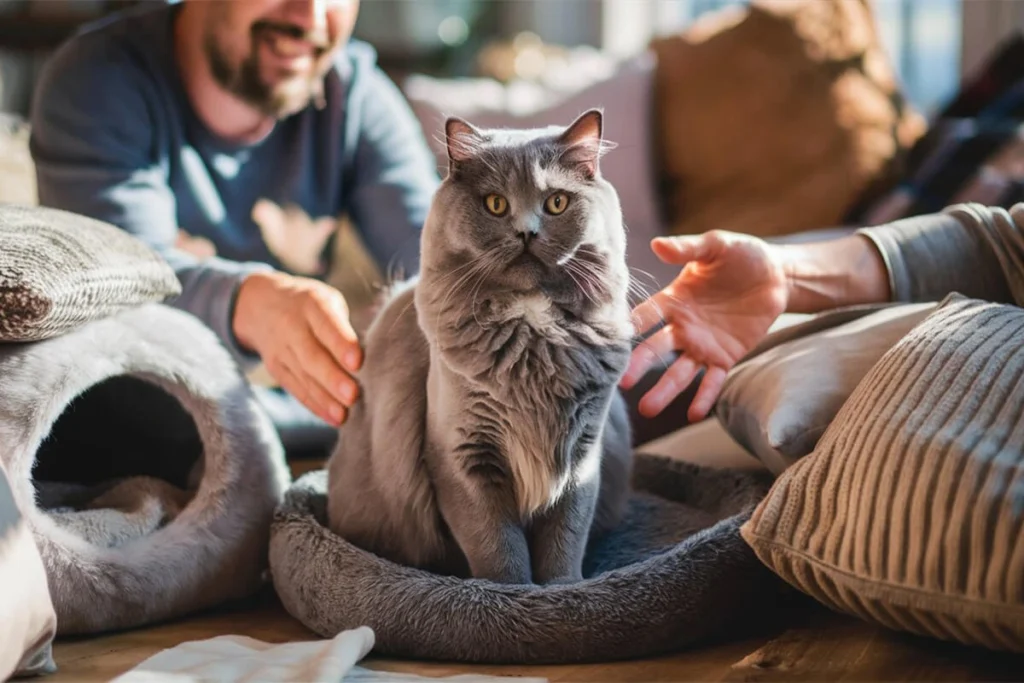
Taking the time to evaluate these factors helps ensure you and your Persian cat enjoy a long, happy life together. Preparing for their needs makes the experience rewarding and stress-free.
How to Provide a Happy Home for Your Fluffy Persian Cat
Bringing a Persian cat into your home means creating an environment where they feel safe, comfortable, and loved. These cats enjoy luxury, routine, and plenty of affection.
- Create a Cozy Living Space
- Persian cats love soft, warm places to relax. Provide plush cat beds, cozy blankets, and elevated perches where they can lounge in comfort.
- Keep their living space clean and free from clutter. Since Persians have long fur, avoid carpets or fabrics that trap fur easily. Regular vacuuming keeps their environment tidy.
- Provide a Nutritious Diet
- Feed your Persian high-quality food with balanced protein, healthy fats, and essential vitamins to support their coat and overall health.
- Ensure they stay hydrated by offering fresh water at all times. Some Persians prefer drinking from a cat water fountain, which encourages hydration and helps prevent kidney issues.
- Maintain a Consistent Grooming Routine
- Brush their fur daily to prevent tangles and mats. Use a wide-tooth comb and soft bristle brush to remove loose hair and distribute natural oils.
- Clean their eyes every day with pet-safe wipes to prevent tear staining. Regularly check their ears and teeth to maintain overall hygiene.
- Engage Them with Gentle Playtime
- Persian cats enjoy low-energy play that stimulates their minds. Wand toys, rolling balls, and puzzle feeders keep them entertained without requiring too much physical activity.
- Since they are not as active as other breeds, provide cat trees, tunnels, or scratching posts to encourage light movement and exercise.
- Keep a Calm and Loving Atmosphere
- Persian cats thrive on routine and stability. Feed them, groom them, and play with them at consistent times each day.
- Offer gentle affection and quiet companionship. While Persians enjoy being around their owners, they prefer calm interactions over rough handling.
- Monitor Their Health Regularly
- Schedule annual vet checkups to detect any health issues early. Watch for signs of respiratory problems, kidney disease, or weight gain.
- Keep their litter box clean and accessible. Persians appreciate a tidy space, and a dirty litter box may discourage them from using it.
- Show Them Love and Patience
- Persian cats build deep bonds with their owners. Spending time with them, offering soft pets, and speaking in a gentle tone makes them feel secure.
- Each Persian has its own personality—some may be more independent, while others crave attention. Respect their individual temperament and give them love in a way they enjoy.
By providing a well-structured and loving home, your Persian cat will feel safe, happy, and cherished. These elegant, affectionate cats bring warmth and companionship to any household when given the right care.
Conclusion
Grey Persian Cats captivate cat lovers with their stunning coats, affectionate nature, and calm personalities. Their luxurious fur and gentle demeanor make them one of the most cherished cat breeds. However, owning a Grey Persian Cat requires dedication to their grooming, health, and overall well-being.
Providing a nutritious diet helps maintain a Grey Persian Cat’s health, while daily grooming prevents matting and keeps their coat silky. Their large, expressive eyes require regular cleaning to avoid infections and tear staining. Since Grey Persian Cats are prone to certain health conditions, such as breathing difficulties and kidney disease, routine veterinary checkups help detect issues early.
Beyond physical care, Grey Persian Cats need a calm, loving home with cozy resting spots and gentle interactions. They form deep bonds with their owners and enjoy quiet companionship. Engaging them with soft play and mental stimulation keeps them happy without overwhelming them.
Choosing a reputable breeder or adoption center ensures you bring home a healthy, well-socialized Grey Persian Cat. Before adopting or purchasing, consider their grooming needs, potential health concerns, and temperament to determine if they fit your lifestyle.
With proper care, love, and attention, a Grey Persian Cat becomes a devoted companion, bringing warmth and elegance to your home. If you are ready for the responsibility, this regal feline will reward you with years of beauty, affection, and unwavering companionship.
Learn More About the Grey Cat Breed On this Page
Discover More Pets and Breeds From Here
You Can Find Good stuff for your Furry Pet on Pet MD Official
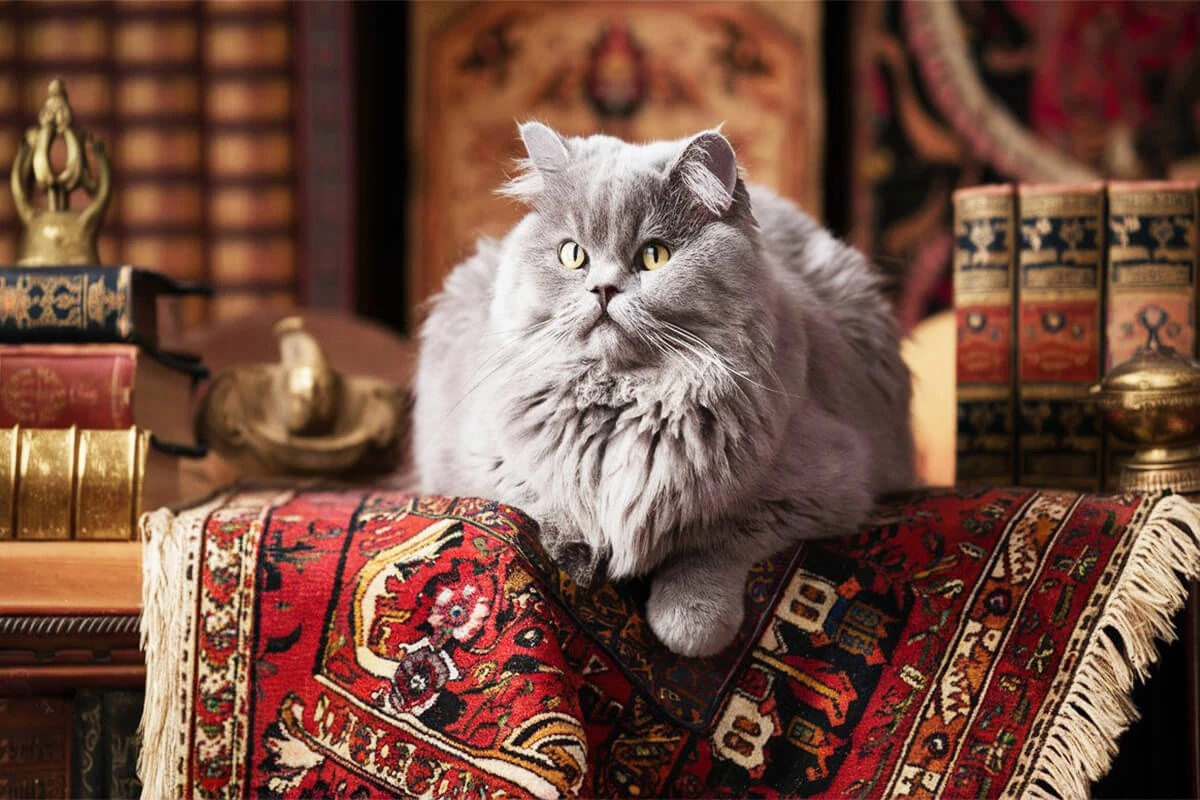
1 thought on “Top 10 Grey Persian Cat Facts That Will Melt Your Heart”
Comments are closed.